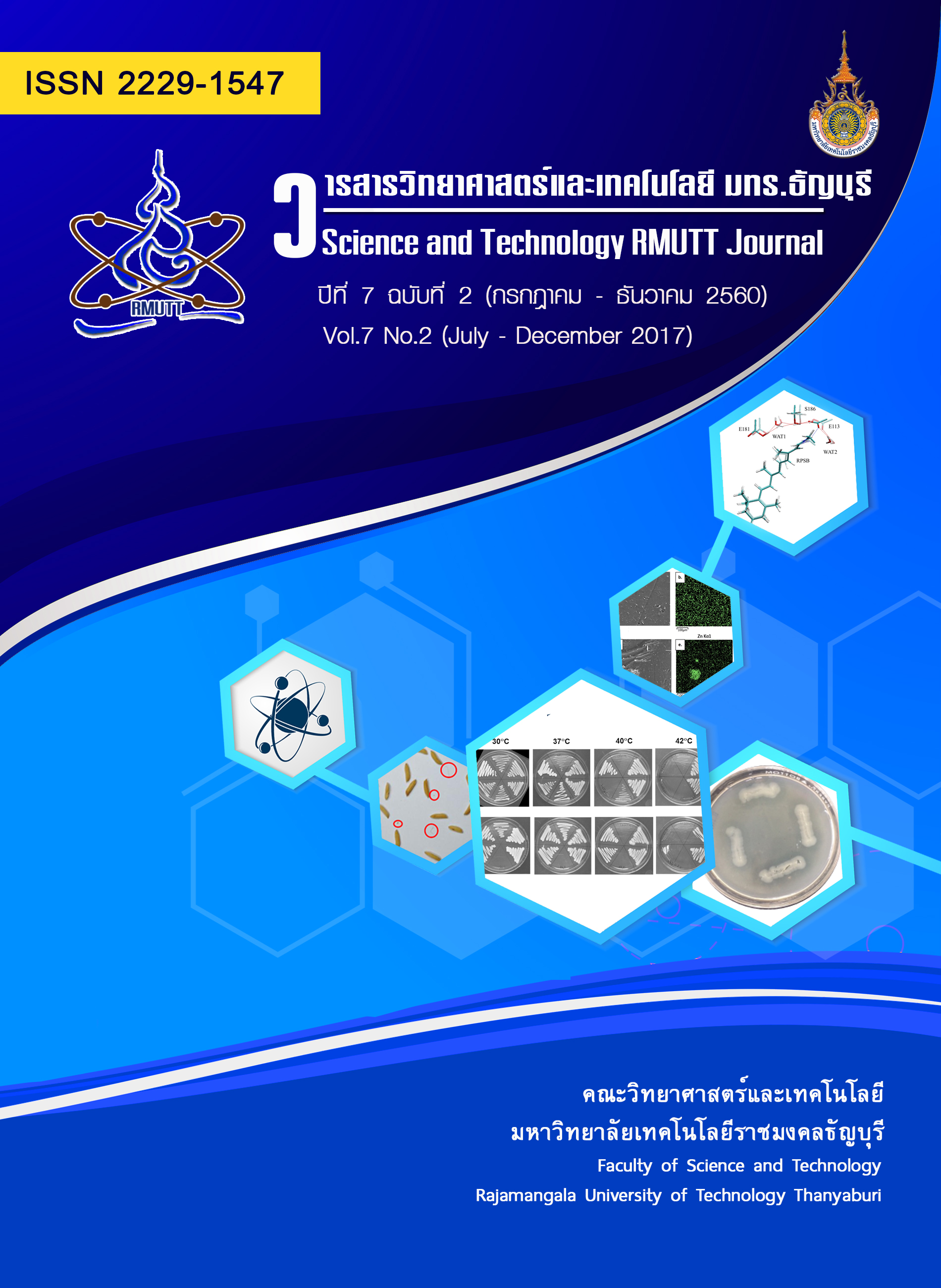Diversity of some organisms in Chiang Mai Rajabhat University, Mae Rim Campus, Chiang Mai Province
Main Article Content
Abstract
The objective of this research is to study the diversity of phytoplankton, benthos, plants, birds, as well as water and soil quality in the area of Mae Rim Campus of Chiang Mai Rajabhat University, Mae Rim district in Chiang Mai province in Thailand. This research was conducted from October 2013 to September 2014. The study found that there were 5 divisions of phytoplankton consisting of 31 species from 22 genera with Ankistrodesmus falcatus, Staurastrum smithii, Cosmarium contractum and Staurastrum sp. as being most prominent. Two phyla consisting of 12 families from 8 Orders of benthos were found and the most abundance species were Macrobrachium sp. (freshwater prawns) and Rhagadotarsus sp. (water striders). Furthermore12 families consisting of 15 species of plants were found, and the most abundance species were Dipterocarpus tuberculatus and Shorea siamensis. Moreover, 15 orders consisting of 106 species from 77 genera within 43 families of birds were also found. That includes 83 resident species, 22 were winter visitors species and one passage migrant species. The concentration of nutrient in the soil was classified as low. The analysis showed that the amount of phosphorus and potassium in soil were 4.50-5.07 mg/kg and 35.67-95.67 mg/kg, respectively. However, from a biodiversity perspective, it can be concluded that the terrestrial and aquatic ecosystem in Mae Rim Campus, Chiang Mai Rajabhat University is suitable for using as local learning areas for students and communities. In addition, the university can use the database of this study to make decisions and to develop a policy on campus development in the future.
Article Details
References
Bunsongthae A. and Thongban S. Cosmetics development for quality improvement of local products in Saloung area, Maerim district, Chiang Mai province. Final Report. National Research Council of Thailand (NRCT), Bangkok. 2012.
Pichai K. The study of the use of some medicinal plant extracts against important plant pathogenic fungi in Saloung area, Mae Rim district, Chiang Mai province for local products development. Final Report. National Research Council of Thailand (NRCT), Bangkok. 2012.
Hydro and Agro Informatics Institute. Handbook of Water Management by local community. 2nd ed. Ministry of Science and Technology, Thailand. 2017.
John D.M., Whitton B.A. and Brook A.J. The freshwater algae flora of the British Isles. Cambridge Press, Cambridge. 2002.
Wehr J.D. and Sheath R.G. Freshwater Algae of North America: Ecology and Classification. Academic Press, San Diego. 2003.
Peerapornpisal Y. Phycology. Chotana Print CO.,LTD, Chiang Mai. 2006.
Peerapornpisal Y. Freshwater Algae in Thailand. Chotana Print CO.,LTD, Chiang Mai. 2013.
Furse M.T., Wright J.F., Armitage P.D. and Moss D. An appraisal of pond-net samples for biological monitoring of loticmacro-invertebrates. Water Res. 1981. 15: 679–689.
Arimoro F.O. and Ikomi R.B. Ecological integrity of upper Warri River using aquatic insects as bioindicators. Ecol Indic. 2009. 9: 455-461.
McCafferty W.P. Aquatic Entomology. Jones and Bartlett Publishers Inc., Boston. 1983.
Stehr F.W. Immature Insects. Vol. 2. Kendall/Hunt Publishing, Iowa. 1991.
Wiggins G.B. Larvae of the North American Caddisfly Genus (Trichoptera). 2nd ed. University of Toronto Press, Canada. 1996.
Sangpradub N. and Boonsoong B. Identification of freshwater invertebrates of the Mekong River and its tributaries. Mekong River Commission. Lao P.D.R. 2006.
Merritt W.R., Cummins W.K. and Berg M.B. An Introduction to the Aquatic Insects of North America. 4th ed. Kendall/Hunt Publishing, Iowa. 2009.
Spilsbury R. and Spilsbury L. Plant classification. Heinemann Educational Books, London. 2008.
Gardner S., Sidisunthorn P. and Anusarnsunthorn V. A field guide to forest trees of Northern Thailand. Kobfai Publishing Project, Bangkok. 2014.
Samitinun T. Thai plant names (Revised edition 2014). Forest and Plant Conservation Research Office, Bangkok. 2014.
Lekagul B. and Round P.D. A guide to the birds of Thailand. Saha Karn Bhaet Group, Bangkok. 2005.
American Public Health Association, American Water Works Association, Water Environment Federation. Standard Methods for the Examination of Water and Wastewater. 21st ed. American Public Health Association (APHA), Washington DC. 2005.
Peerapornpisal Y., Pekkoh J., Powangprasit D., Tonkhamdee T., Hongsirichat A. and Kunpradid T. Assessment of water quality in standing water by using dominant phytoplankton (AARL-PP Score). J Fisheries Technol Res. 2007. 1(1): 71-81.
Office of Science for Land Development. Manual of chemical analysis of soil. Land Development Department, Bangkok. 2010.
Pollution Control Department. Survey, Collection and analysis of water samples and living organisms in the standing water. Final report. Vol. 2. Ministry of Natural Resources and Environment, Bangkok. 2010
Mustow S.E. Biological monitoring of river in Thailand; use and adaptation of the BMWP score. Hydrobiologia. 2002. 479: 191-229.
Rekwanpen P. Human being and environment. Chiang Mai Rajabhat University Press, Chiang Mai. 2002
Bunyavejchewin S. Structure and dynamics of deciduous dipterocarp forest, mixed deciduous forest and moist deciduous forest from large-scale plots. Final Report. Forest and Plant Conservation Research Office. National Park, Wildlife and Plant Conservation Department, Bangkok. 2002.
GIS Enterprise Database. 2010. Chiang Mai Governor Office. http://gis.chiangmai.go.th/index.php?name=database. Accessed 15 December 2013.
Lindenmayer D.B, Franklin J.F. and Fischer J. General management principles and a checklist of strategies to guide forest biodiversity conservation. Biol Conserv. 2006. 131: 433-445.
Caprio E., Ellena I. and Rolando A. Assessing habitat/landscape predictors of bird diversity in managed deciduous forests; a seasonal and guild-based approach. Biodivers Conserv. 2009.18: 1287.
Hewson C.M., Austin G.E., Gough S.J. and Fuller R.J. Species-specific responses of woodland birds to stand-level habitat characteristics: The dual importance of forest structure and floristics. Forest Ecol Manag. 2011. 261: 1224-1240.
Steven R., Pickering C. and Castley J.G. A review of the impacts of nature based recreation on birds. J Environ Manage. 2011. 92: 2287-2294.
Leelahakriengkrai P. Water quality and biodiversity of phytoplankton of Mae Jok Luang and Huai Tueng Thao reservoirs in Mae Rim District, Chiang Mai Province. Academic Journal: Uttaradit Rajabhat University. 2014. 9: 173-184.
Leelahakriengkrai P. and Chaiplern N. Diversity and seasonal distribution of phytoplankton in the King Rama IX Royal Park reservoir, Chiang Mai Province. KMUTT Research and Development Journal. 2015. 38: 145-15.


